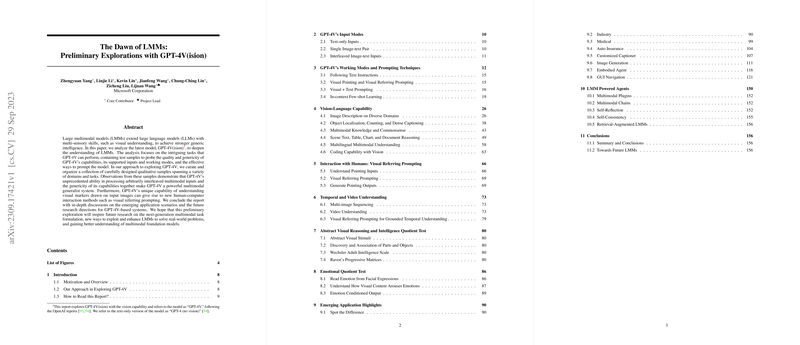Overview of "The Dawn of LMMs: Preliminary Explorations with GPT-4V(ision)"
The paper "The Dawn of LMMs: Preliminary Explorations with GPT-4V(ision)" presents a comprehensive investigation into the abilities and potential applications of large multimodal models (LMMs), specifically focusing on the capabilities of GPT-4V(ision) (referred to as GPT-4V). Developed by researchers at Microsoft Corporation, the paper aims to extend the current understanding of LLMs by incorporating visual understanding into the paradigm, thus harnessing the synergies between textual and visual inputs to achieve more generalized intelligence.
The exploration of GPT-4V centers around several key questions:
- Supported Inputs and Working Modes: GPT-4V's ability to handle and interpret arbitrary mixes of images, text, and visual pointers is presented as a significant advancement. The paper discusses various supported input forms, including text-only, single image-text pairs, and interleaved image-text inputs, highlighting the model’s unparalleled versatility.
- Quality and Genericity of Capabilities: The authors probe GPT-4V's performance across a diverse range of domains and tasks. These include open-world visual understanding, object localization and counting, scene text recognition, dense captioning, and various forms of visual reasoning, such as handling temporal sequences in video frames. The qualitative results show that GPT-4V demonstrates impressive generality and human-like comprehension in handling these complex multimodal interactions.
- Effective Prompting Methods: The paper explores innovative ways of prompting GPT-4V to maximize its performance. A novel method introduced is "visual referring prompting," which directly edits image pixels to include visual pointers and scene texts, enabling nuanced interactions that are well understood by GPT-4V. This approach enhances the precision of visual queries and is illustrated as being particularly effective in application scenarios such as grounding image descriptions and conducting visually grounded dialogues.
- Future Directions and Applications: The discussion culminates in an overview of promising future directions and novel application scenarios. These include the integration of multimodal plugins for time-sensitive knowledge retrieval, chaining GPT-4V's capabilities for structured tasks like multimodal reasoning and interactions, as well as specialized applications in domains such as industry (e.g., defect detection, safety inspections), medicine (e.g., radiology report generation), and home assistance (e.g., facilitating tasks with home robots).
Numerical Results and Performance Highlights
Throughout the paper, although the primary focus is on qualitative results due to the novelty and breadth of tasks explored, the depth of analysis provides robust evidence of GPT-4V's capabilities. For instance:
- Object Counting and Localization: Examples illustrated that GPT-4V could reliably count and describe objects within complex scenes.
- Temporal Reasoning: The model demonstrated an ability to understand and reason about sequences of events, such as accurately predicting future frames in a series of video stills.
- Dense Captioning: By combining segmentation techniques with dense image descriptions, GPT-4V generated precise and contextually rich narratives for each segmented object.
Implications and Future Developments
The implications of GPT-4V extend into both theoretical and practical realms. Theoretically, the integration of robust visual understanding into LLMs marks a significant milestone in achieving generalizable artificial intelligence. Practically, the model’s capabilities herald a range of applications from enhancing human-computer interaction to automating complex tasks in real-world settings.
The paper provides a speculative yet insightful look into future enhancements for LMMs, such as incorporating multimodal plugins to keep models up-to-date with real-time information, leveraging multimodal chains to handle complex, structured tasks, and facilitating continuous learning from web and real-world environments.
In summary, this paper documents the substantial progress made in developing multimodal models like GPT-4V and outlines a direction for future research and application. It serves as both a milestone in the evolution of multimodal AI and a roadmap for subsequent advancements in the field.
